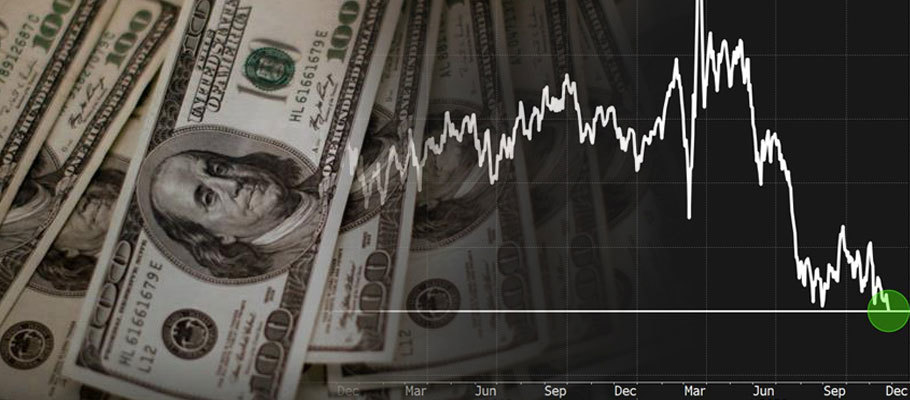
Published: December 1st, 2020
The dollar index dipped on Friday, November 27, touching its lowest point in three months. Market analysts think the robust economic data that came out of China had something to do with the slip. The positive numbers created an appetite for commodity currencies over safe-havens. Also, equities markets took the cue and rallied.
The dollar index was down on Friday, November 27. This dip compounds the general slip that followed the election of U.S. President-elect Joe Biden. Following the Democrat’s win, the greenback is now down more than 2.2% for the month as global market sentiments keep surging.
The demand for safe-haven currencies has further been injured by the several positive vaccine news on the candidates seeking emergency use approval.
The Australian dollar hit the highest point since September following news that China’s industrial firms have maintained steady growth in October. This data now indicates that China’s industrial growth has continued unabated for six consecutive months, the quickest since early 2017.
The steep, steady climb also points to an ongoing recovery in the country’s manufacturing sector after the hard-hitting effects of the coronavirus pandemic.
While the Australian dollar was enjoying an unbridled ride, the Great Britain pound slipped against the euro. The pound’s dismal performance is attributed to the happenings in Europe. Both Britain and the European Union said substantial differences still exist regarding a Brexit trade deal.
The EU chief negotiator, Michel Barnier, arrived in London on Friday, November 27 to attempt a last-ditch talk with his British counterparts to forestall a thunderous end to the five-year Brexit crisis.
According to Erik Bregar, head of FX strategy for the Toronto-based Exchange Bank of Canada, the Australian dollar’s impressive rise is not only because of the data from China and the Brexit news. He said that month-end disposing of the greenback as investors struggle to balance portfolios following substantial equities gains in October might have also contributed.
He added that news flooded the markets the entire past week that the greenback would experience massive sell-off waves extending to Monday, November 30.
Bregar also saw a dollar selling into the London fix for all the six days of the week that ended on Saturday, November 28.
The Dow Jones Industrial Average, S&P 500 Index, and Nasdaq did exceptionally well. The Dow even managed a record high of 30,000 points as optimism surrounding an economic rebound in 2021 outweighed concerns of a possible surge of new coronavirus infections. Health experts have warned of an imminent massive rise in infections following the record-breaking travel that characterized the Thanksgiving weekend in the U.S.
Jane Foley, the senior FX strategist of the Dutch multinational investment bank, Rabobank, said that the markets witnessed indexes hitting all-time highs. According to her, the surge led to the dollar pressure. However, she added that the anxiety was also heightened by the perception that the Federal Reserve will act, when necessary, especially if the Congress disagrees on a stimulus package before Christmas.
According to Foley, the combination of the mentioned factors pressured the yield curve to lean downwards. Minutes of the Fed’s latest meetings indicate the willingness of policymakers to provide new guidance on bond-buying soon.
Overall, the dollar slipped by 0.24% compared head to head with the basket of major currencies. This downward trajectory is only its lowest since September 1, when the greenback set a 2020 low. The dollar-yen index tanked by 0.16%.
The Australian dollar, which is the markets’ liquid proxy for risk, climbed to its highest point in almost three months during the early London trading session. The currency managed more than 0.5% surge in the said session, settling at 0.7394.
News from Down Under regarding coronavirus infections is helping boost the Australian dollar’s runaway surge. Victoria, the country’s second-largest state, and for a long time its COVID-19 hotspot, announced on Friday, November 27, that is has recorded 28 consecutive days of zero new infections.
The Great Britain pound dipped some 0.03% against the dollar while the euro gained 0.26% against the British currency. Meanwhile, the euro index surged with the currency gaining 0.29% to stand at $1.1945. The Euro bloc’s currency reacted only mildly to the negative comments of Philip Lane, the chief economist of the European Central Bank.
Lane said on Thursday, November 26, that the macroeconomic hit arising from COVID-19 would likely stretch past the rolling out of medical solutions including vaccines and therapeutics.
While addressing an online audience of the Department of Economics of Trinity College Dublin, Lane said that were it not for the actions of the ECB in responding to the pandemic, the Eurozone’s economic output would have dropped by a further 1.3%. The economist also added that his bank’s actions had curtailed an additional 0.8% dip in inflation cumulatively for 2022.
With market participants preferring the euro, Foley, Rabobank’s FX strategist, said that the euro-dollar pair might face downsides since the ECB has indicated that it is keeping tabs on the euro’s appreciation. Her predictions might turn out right or wrong, depending on the outcome of the bank’s actions in the days to come.
The EU budget, which covers the COVID-19 recovery package is yet to get a nod. However, there is optimism it might. During Lane’s address, he reiterated that lower-income households have been hardest hit by the effects of the pandemic and got a correspondingly large share of governmental support. These comments prompted economist to opine that even more help will come the way of this social class soon.
The dollar index has fallen to its lowest in almost three months. The drop affected the greenback, seeing it dipping against each of the members of the basket of major currencies. Market analysts provided several reasons for the decline, including impressive economic data coming out of China and positive vaccine news. Because of the said reasons, the demand for other currencies has surged. At the same time, the greenback’s demand is under pressure.